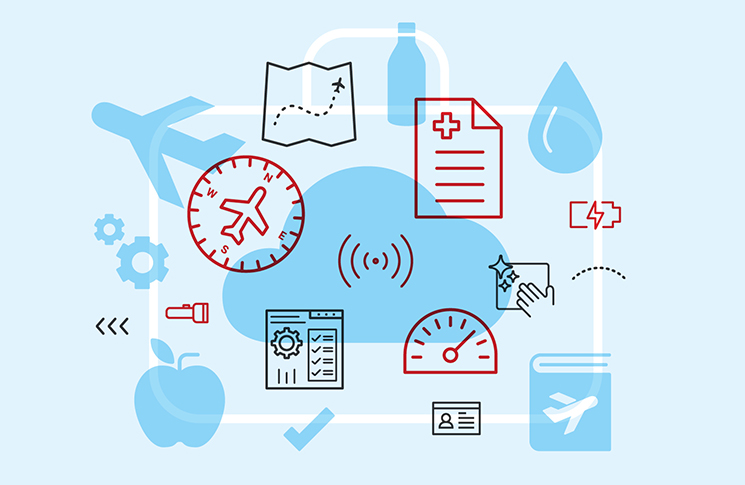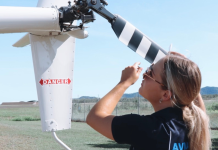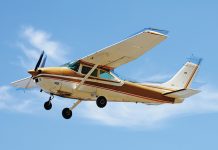Imagine it’s a beautiful sunny day and you’ve planned for a short hop interstate. You complete the pre-flight checks, position the electronic flight bag (EFB) in front of you and take off. But, about halfway through the flight, you‘re dismayed to realise your iPad has suddenly shut down because it’s been sitting in the sun! What do you do now?
If you’re well prepared, you’ve planned for this. You simply reach into your well-stocked nav bag for your backup maps and carry on.
Sometimes overlooked, a pilot’s nav bag can play a crucial part in flight planning. If you fly different types of aircraft, a well-stocked nav bag can ensure you have the right equipment for each flight.
CASA Aviation Safety Advisors Craig Peterson and Terry Horsam recommend some items to consider taking onboard to help you prepare for the unexpected.
‘We fly in a very dynamic environment,’ Craig says. ‘Things can change really quickly and not always in our favour. That’s why it’s important to plan for these instances.’
The required items
Part 91 of CASR outlines items that pilots are required to take onboard: pilot licence or certificate, medical certificate and a form of photographic ID.
You must also have the aircraft’s flight manual, minimum equipment list and any operating instructions for computerised navigation systems fitted to the aircraft.
For some flights, for example, if you’re flying over 50 nautical miles from your departure aerodrome, you must also carry the aeronautical information for the flight. This includes aeronautical maps and charts, NOTAMs and information about the aerodromes you’re visiting. You must also carry the aircraft’s flight technical log or its maintenance release.
Most pilots choose to carry these items in electronic form on an EFB.
The ‘nice to have’ items
Then there are the ‘nice to have’ items that Craig says aren’t required but cover the ‘what-ifs’ of flying.
‘What if your iPad breaks down or overheats? What if the weather changes? What if your GPS fails?’ he says. ‘Have you got stuff with you to enable you to finish the flight safely?’
Flight planning backups
EFBs have eased the load of flight planning significantly. They allow you to have your flight planning information, such as charts, maps and NOTAMs, right at your fingertips. While a great piece of technology, they can also pose a risk if you rely on them too much.
Craig recommends that pilots always carry printed backups for those scenarios where the EFB shuts down unexpectedly.
‘This could include a backup map for your nav route or the en route supplement pages for the airfields you’re going to,’ he says. ‘Another option is a whiz wheel, or what is called the flight computer.’
The flight computer can help you manually calculate your fuel consumption and groundspeed.
‘The Bureau of Meteorology also puts out some good weather decode charts. These are good to carry in case you may not remember the codes.’
Terry recommends that pilots carry a spare battery or power bank in case the EFB dies; however, make sure it is properly stored and checked for any damage before take-off.
What if your iPad breaks down or overheats? What if the weather changes? What if your GPS fails?
Practical items
Both Craig and Terry recommend carrying a fuel strainer and a mini torch.
‘These won’t always be in the aircraft and help with important steps in your pre-flight checks,’ Craig says.
Another item that pilots may not consider is a chamois to remove any dirt or grease on the windscreen.
Although not required, a portable electronic carbon monoxide (CO) detector is highly recommended.
‘They will beep at you if they detect CO in the atmosphere – it is a great investment. They’re small, inexpensive and reliable,’ Craig says.
Don’t forget your own wellbeing. Remember those items that will keep you comfortable such as some snacks, a bottle of water and a hat.
‘Think about things to have with you in case you’re waiting at an airfield for friends or a refueller,’ Craig says.
Other practical items include insect repellent, sunblock and a light travel raincoat.
‘Think small travel items that won’t take up a lot of room in your bag,’ Terry says.
Emergency items
If you’re flying in a designated remote area, you must carry survival equipment that is suitable for that area.
‘Think about the hierarchy of survival items – first aid, clothing, shelter, water and food,’ Terry says.
‘It’s a good idea to have a personal locator beacon but ensure that it’s registered with the Australian Maritime Safety Authority [AMSA],’ he says.
According to AMSA’s website, beacons transmit a signal to the international search and rescue satellite system Cospas-Sarsat which then notifies the nearest ground station. If your beacon is registered, AMSA will look up your details and ring your emergency contacts immediately. If emergency contacts are aware of trip details or trip details have been submitted online, search operations can begin quickly.
‘Another great item to carry is a space blanket. This packs down really small and can be used if you’re stranded overnight, or when placed under your personal locator beacon can help increase the signal range. Because it is shiny, it also makes an excellent signalling device,’ Terry says. 
CASA’s Visual Flight Rules Guide provides practical tips for planning for emergency situations and safety advice in instances where you must make a forced landing. Get your copy at shop.casa.gov.au.






